Product News
2019/07/01
A World-Class Music Production Studio has Opened at the Zhejiang Conservatory of Music (ZJCM)
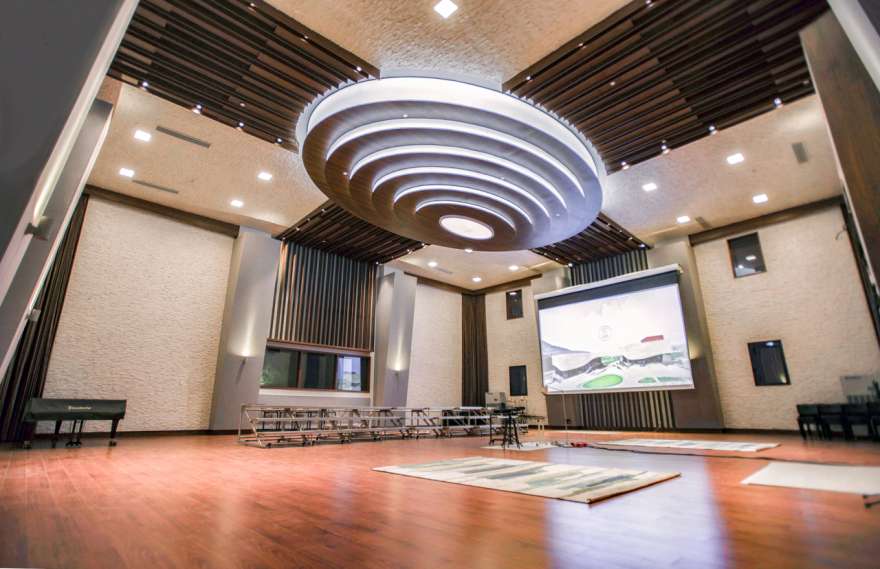
WSDG's ceiling cloud doubles as acoustic treatment and light fixture
Three years ago, the Zhejiang Conservatory of Music was opened on a 100-acre campus, offering nine concert halls, 102 rehearsal halls, 842 practice rooms, six studios and a 60.1 multitrack laboratory. This important addition to China’s educational landscape came about with a government investment of RMB4 billion, which transformed the former music school of Hangzhou Normal University in a bid to compete with the best of musical academies worldwide.
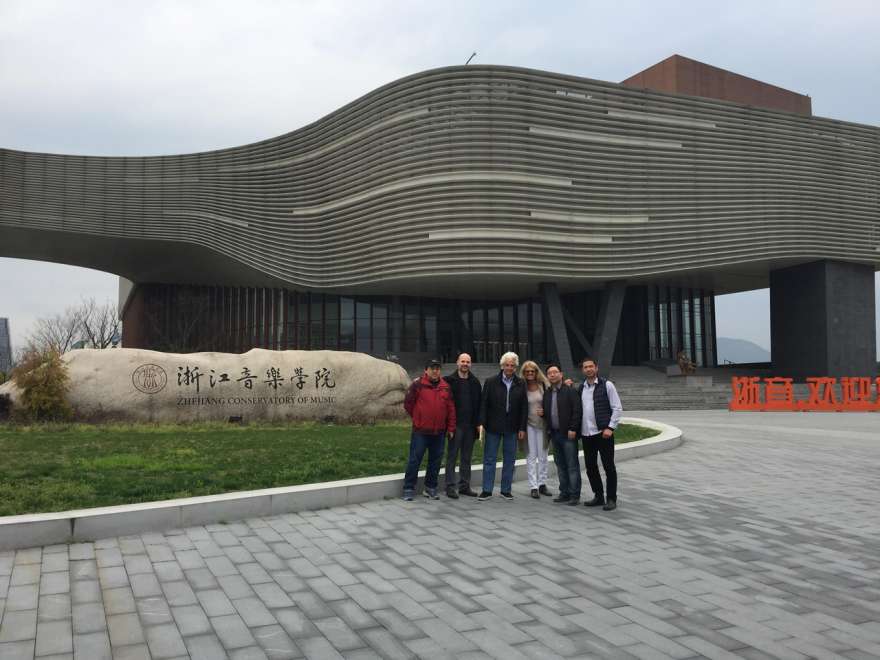
Contractor Guo Ming; WSDG's Víctor Cañellas, John Storyk and Beth Walters; DMT's Johnathan Wang and WSDG China's Su Weilie outside ZJCM
In 2017, a new commission was issued: to provide ZJCM with a music production studio capable of hosting a 100-member orchestra, together with a 91m2 control room – ample space for students and performers to listen to the mix. Winning the contract to design and install the new studio at ZJCM were the Walters-Storyk Design Group (WSDG) and Chinese pro audio distributor, DMT.
‘Zhejiang province hasn’t had a good studio until now,’ says Huang Xiaodong, deputy dean of ZJCM’s music and engineering faculty. ‘All our important recording projects had to go to Beijing and Shanghai; we couldn’t do them here in Zhejiang. The goal of our studio is to serve not only the conservatory but the province too. The studio will also attract first-class orchestras and recording engineers, which can help us in teaching the students.’
ZJCM offers a wide range of music and arts teaching for students from China and beyond. Programmes range from composition, conducting, vocals and instruments to music technology, drama studies and dance. There are 12 faculties and four professional performing ensembles, and the campus can accommodate up to 5,000 full-time students. The music and engineering faculty has three departments: music design and production, recording technology, and art and science.
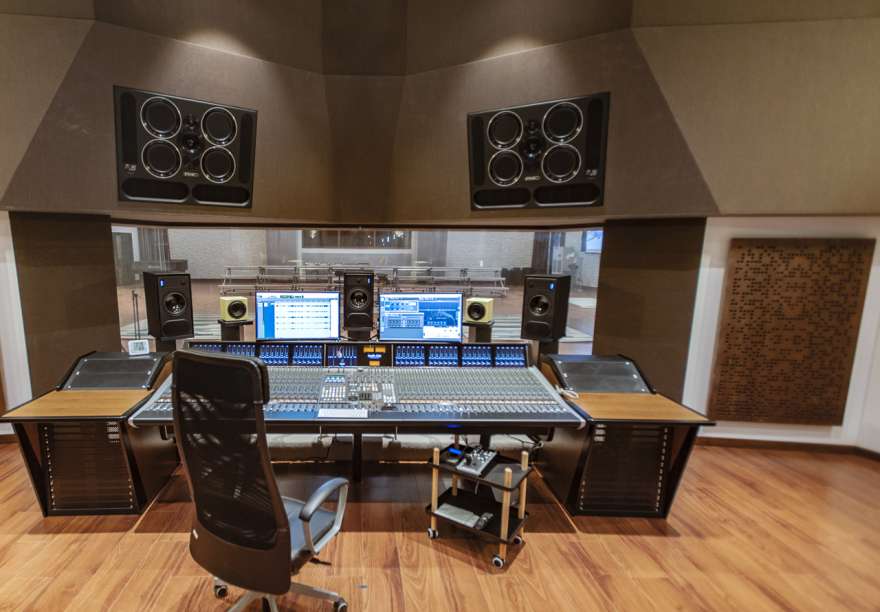
SSL Duality console and PCM monitoring in the control room
‘Though the music industry in China is developing very fast, we are lacking in standards and systems, and have to rely on Western products as our own brands and technologies are far behind,’ continues Huang. ‘Our university has an obligation to start doing fundamental research, so that’s why we have a department of art and science. Apart from music, the students in this department must have a wide knowledge of mathematics and programming. The government hopes we experience rapid growth in science and electronic technology, and become one of the top music colleges in China.’
Seven small existing studios were demolished to make space for the new facility, which features a 975m2 live room with an 8m-high ceiling, and 198m2 control room installed with an SSL Duality console and PCM monitoring.
‘When we decided to build the studio, we welcomed proposals from a wide range of companies,’ says Huang. ‘Finally we chose DMT; besides the products that they represent, the service they provide is also key. We needed someone who understood acoustics. If there was a problem with the equipment, we would be able to fix it later, but if something was wrong the acoustics, it would be very difficult to fix. DMT has a lot of experience in building studios; they are a very professional company that can meet the strict governmental procurement bidding process.’
DMT brought in WSDG to work alongside them on the first-floor studio; the first time the companies had collaborated on a project. WSDG’s 50-strong creative and technical team, led by founding partner John Storyk together with partners Sergio Molho and Renato Cipriano, set to work on the project. The company, which has branches across the globe, deployed staff at its Swiss and German offices to develop 3D room modelling and electro-acoustical surface predictions, while the Latin office provided accurate renderings and the US and Brazil team handled overall design and acoustic solutions. Interior design was completed by Miami-based partner/art director, Silvia Molho. An important member of the WSDG team was Guangzhou-based representative, Víctor Cañellas, whose knowledge of acoustics, studio design, isolation construction issues and China’s educational criteria were instrumental in keeping the project on track.
‘Considering ZJCM’s world-class goals for their new studio, exquisite décor, superb acoustics and isolation design were critical, and WSDG was our immediate choice,’ says DMT’s technical director, Johnathan Wang. ‘My boss, Clement Choi, was in full agreement. With his enthusiastic support our collaboration began.’
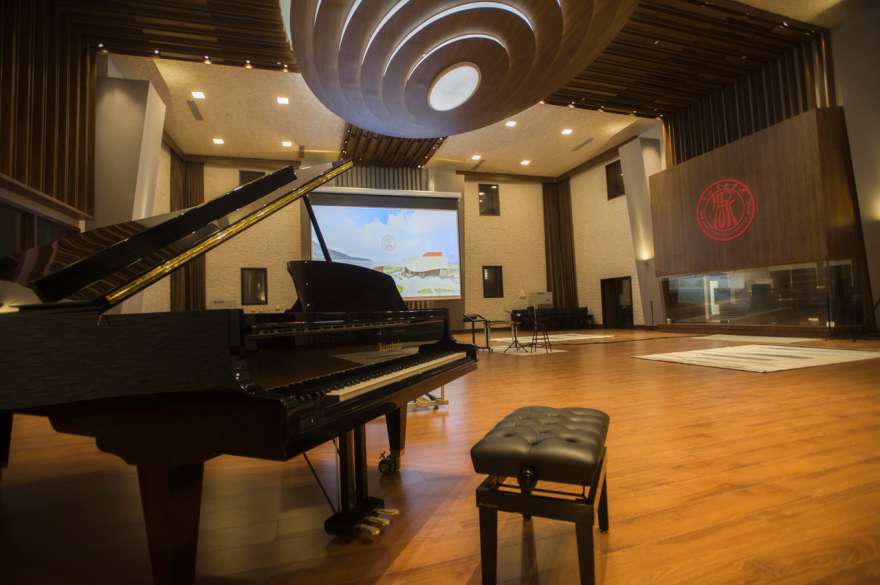
The spacious live room
Huang and Cañellas, together with Guo Ming, head of the ZJCM decoration construction team, worked closely with DMT on the studio, which presented many creative opportunities for WSDG. ‘The scale of the live room provided us with an extraordinary canvas for acoustical and aesthetic creativity,’ says Cipriano. ‘We designed a number of elements that we believe will inspire students, musicians and educators alike. One of our proudest accomplishments was the huge oval ceiling cloud/lighting element. Floating over the live room from a height of 8m, it provides a strikingly effective visual element as well as mood lighting and acoustic treatments.’
This ceiling cloud has been fitted with a telescoping acoustical treatment, establishing multiple diffusion layers to meet different requirements. ‘It is based on the fundamental acoustical concept of scattering a wide range of frequencies, contributing to the diffusive sound field and enhancing the reverberation characteristics of the room,’ continues Cipriano. ‘Besides the acoustical properties, it also works as a large LED fixture, expanding the lighting possibilities and enhancing the aesthetics of the space.’
‘The ceiling was a brave design, and it scared us in the beginning,’ admits Huang. ‘I’d never seen a recording studio with a ceiling like this. But WSDG convinced us because they’ve built so many amazing studios around the world. When designing each studio, they consider the local cultural elements of each country.’ This time, WSDG found inspiration for the shape of the ceiling cloud in the design of the Chinese decorative knot, often used as a symbol of good fortune in Feng Shui.
Another WSDG implementation was to hang 8m-long absorbent curtains from silent, motorised tracks on each of the live room’s four walls. Deploying these curtains can provide as much as a 50% modification of the room’s diffusion and reflection properties.
When it came to equipping the studio, DMT was committed to providing ZJCM with what it considered to be an outstanding technology package. ‘For the audio system, we recommended an SSL Duality console and PMC QB1-A large-scale monitor speakers as an unparalleled sound system,’ says Wang. This is accompanied by an Avid Pro Tools HDX3 system with MTRX interface, a 5.1 system of five PMC twotwo.8 monitors and a twotwo sub2 subwoofer, and an SNS EVO media storage server.
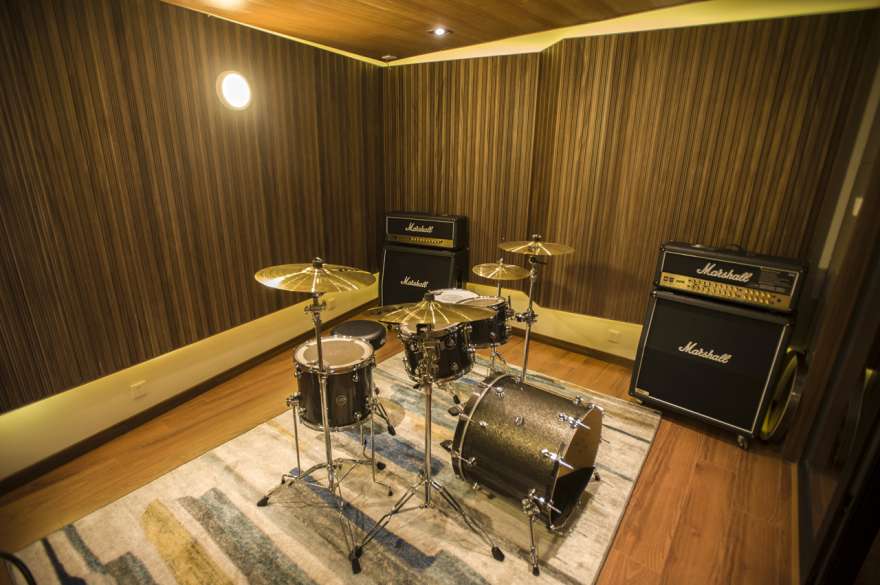
WSDG has provided a panoramic, floor-to-ceiling window view from the control room into the live room. ‘We didn’t want to make this studio like a traditional, confined space; we wanted to have natural light,’ says Huang.
When the studio was complete, a number of choirs, musicians, sound engineers, composers and senior members of the Singapore National Orchestra were invited to tour the new facility, together with representatives of Zhejiang province’s Hengdian World film studio.
‘They were all greatly pleased with the sound quality, and their directors have already begun to contact us regarding the possibility of recording here,’ says Huang who, together with the rest of his faculty, is justifiably proud of the new studio. ‘On the first day of trial recording, we didn’t need to do any postproduction as the sound reproduced by the monitors was true and natural – an ideal sound quality with natural reverberation. This is due to the good acoustic design and the technical precision of the studio’s construction.’
The studio is also fulfilling ZJCM’s commitment to research. ‘We’ve been given an important project funded by the National Development and Reform Commission of Zhejiang province – the digital music engineering centre of Zhejiang,’ says Huang. ‘We need to cooperate with other organisations to build a platform for production, study and research. This will not only be a platform for our university but for the entire province.’
Good news, then, for the students of ZJCM and the people of Zhejiang province alike.
This article first appeared in the March-April 2019 edition of Pro AVL Asia. Subscribe at proavl-central.com/subscribe.
www.dmtpro.com
www.wsdg.com
